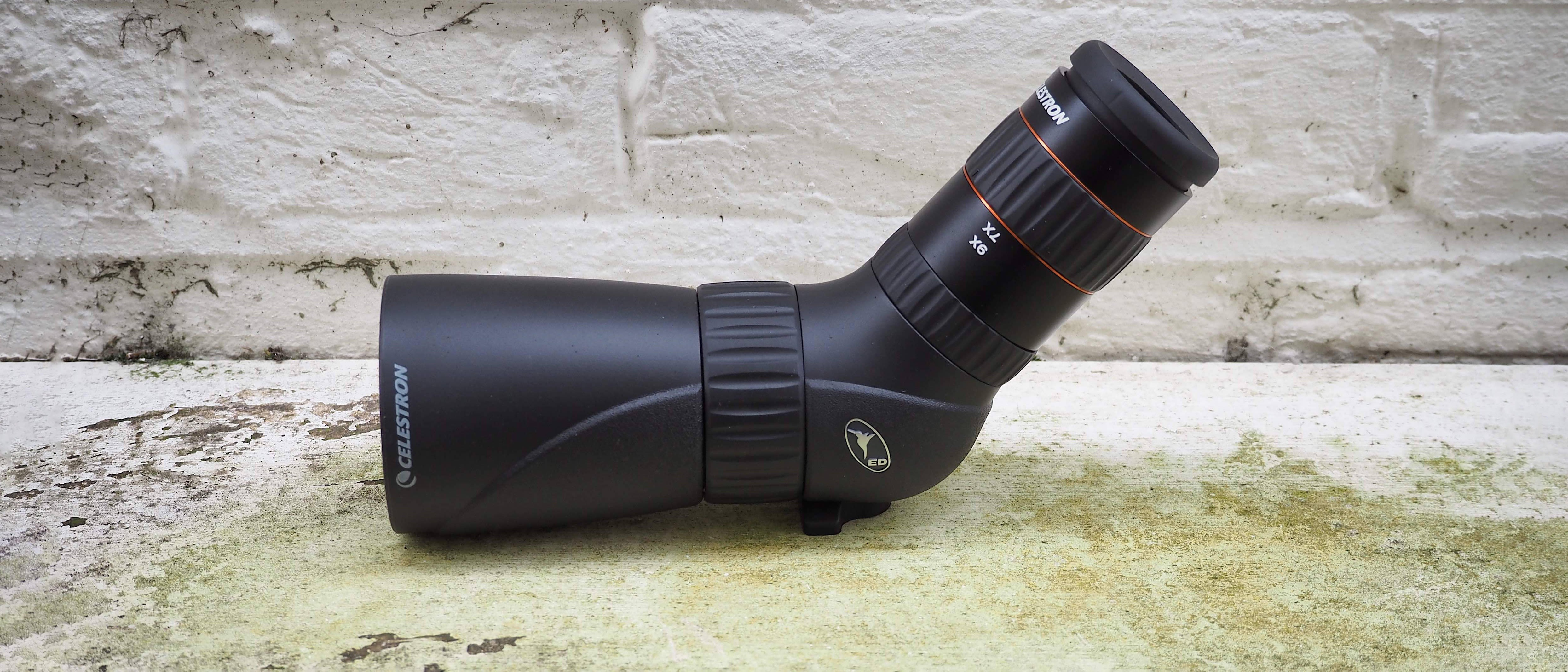Digital Camera World Verdict
Compact, travel-friendly yet powerful spotting scope for wildlife watchers that can either be used handheld at its minimum magnification (9x) setting or attached to an optional tripod for a judder-free view at maximum magnification (27x). Either way, we’re blessed with a large and bright 56mm objective lens to allow ongoing observation whether at dawn or dusk, plus a waterproof and fog-proof body so that challenging climates won’t stop play.
Pros
- +
Variable magnification capability
- +
Sturdy construction
- +
Just about portable enough
Cons
- -
Requires an additional tripod purchase – or at least a level surface
- -
Softening towards the edges of the frame
Why you can trust Digital Camera World
A spotting scope is something that is in between the best monoculars and best telescopes, with a smaller and more compact size than a telescope, but much more powerful optics than a monocular. The best spotting scopes are used mostly for bird and wildlife watching, as well as hunting, and observing the night sky.
We recently reviewed the Celestron Outland X 10-30x50mm monocular and described it as being closer to your typical spotting scope than a regular monocular. Not only did it resemble a spotting scope that had been miniaturized, but that product also offered the ability to vary magnification from 10-30x and all points in between. The step-up product is this physically larger but still relatively compact Celestron Hummingbird 9-27x56mm ED micro spotting scope, which offers an even bigger, brighter lens for a theoretically clearer view in lower light levels.
The 56mm objective lens is here married to a marginally less powerful magnification range that runs between a standard monocular-like spec of 9x, thus allowing this to be used as a substitute for a monocular/binocular when we don’t want to carry both, up to a maximum 27x.
In essence, it’s a spotting scope for bird watchers and nature lovers always on the move; those wanting an observational aid that’s relatively powerful yet lightweight and compact with it. Presumably naming it after this particular small bird is supposed to amplify its compactness and versatility.
For comfort when viewing subjects for prolonged periods of time, we get a screw thread to enable this Celestron to be tripod mounted. As there is no image stabilization built into the scope, investing in a tripod of a similar travel-friendly size would help prevent any visible wobble the more we increase the magnification. Well, that’s the theory at least; let’s see how well this Hummingbird scope pans out in practice.
Specifications
Magnification: 9x-27x
Objective lens diameter: 56mm
Field of view at 1000 yards: 216-98
Closest focusing distance: 3 metres
Eye relief: 15mm
Weight: 590g
Dimensions: 21.3x13x6.1 cm
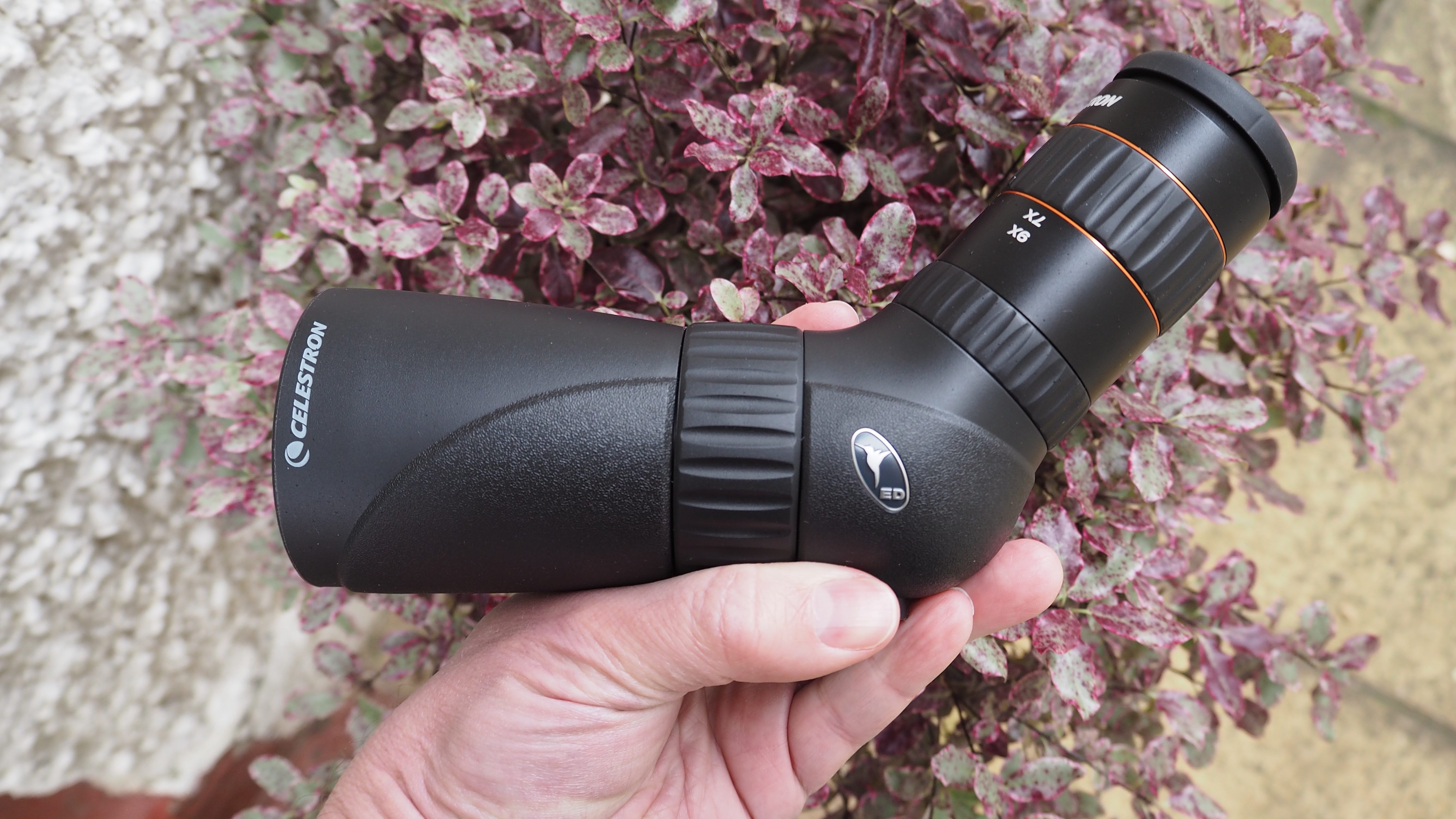
Key features
As we’d expect, the key features of the angled Celestron Hummingbird 9-27x56mm ED micro spotting scope are all there in the model name. We have the ability to adjust our magnification from 9x to 27x – and anywhere in between – coupled with a larger-than-average 56mm objective lens. The rough rule of thumb is the bigger the lens the better; after all, the more light allowed in the brighter the view.
Obviously being able to vary the magnification is helpful for those tracking moving subjects – particularly when our subject is nervous wildlife that would otherwise be disturbed by humans in close proximity. The ‘ED’ part of the name signifies the inclusion of Extra-low Dispersion glass. The construction further includes BaK-4 prisms, along with fully multi-coated optics to aid clarity of view, all features we’d expect to find at this price point.
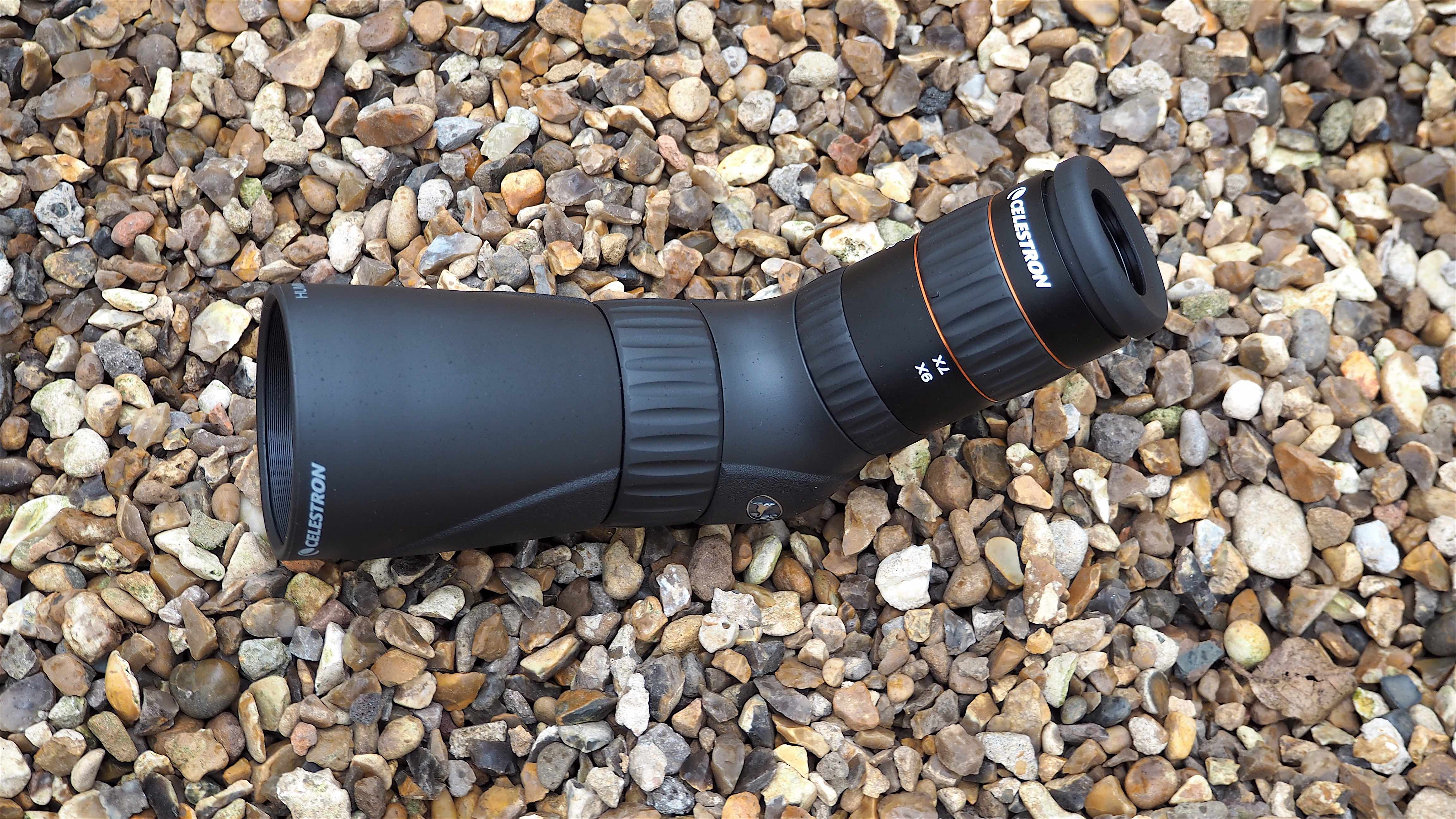
Offering a degree of flexibility and a 45° viewing angle for comfort, the scope can be used as close as 10ft from our subject.
Unsurprisingly given that most users of this scope will be venturing into the great outdoors, the device is handily waterproofed and nitrogen filled to prevent fogging. For further versatility if required – for example if we want to use the scope for astronomy – there’s the ability to swap out the eyepiece it comes supplied with and substitute a wide range of optional 1.25-inch mount eyepieces, likewise available via Celestron at additional cost.
Build and handling
As usual with this brand, the build quality is good. The design looks slick and the scope has a reassuringly solid feel at 590g when gripped in the palm. While the dimensions are certainly compact enough for this scope to be used handheld, a screw thread for tripod mounting proves a practical necessity.
When tripod mounting, the 45° angled eyepiece comes in very handy, avoiding the need for us to crouch down, or otherwise have our tripod set to its maximum height to enable a comfortable viewing angle. An actual tripod is an optional extra of course.
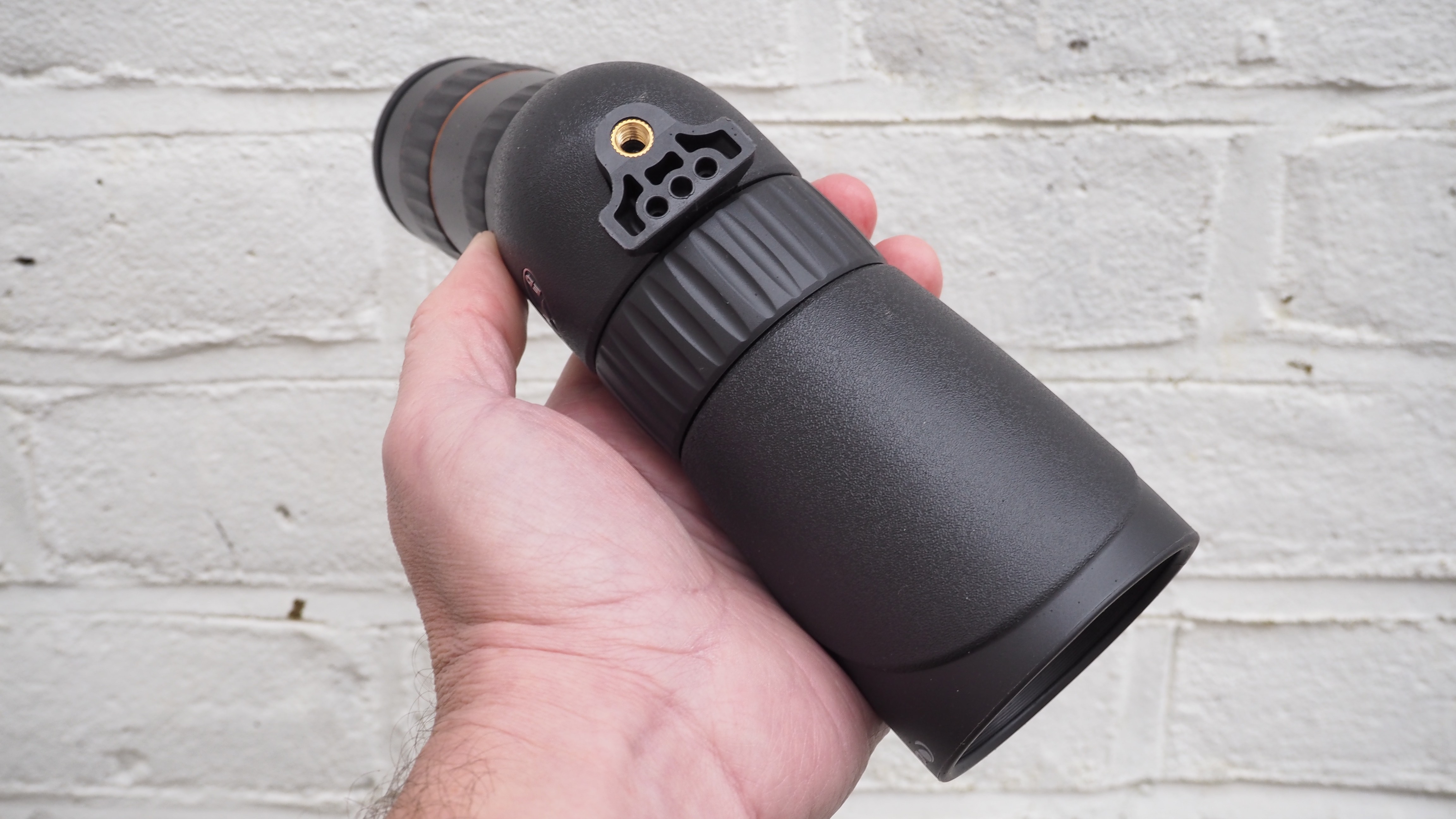
In terms of operation and handling, we get two chunky rubberized and ridged control dials on the Celestron Hummingbird 9-27x56mm ED Micro Spotting Scope – the thinner one nearest the eyepiece with attractively copper-colored rings is for adjusting the magnification from 9x to 27x equivalent, while the thicker one nearest the lens is the manually operated focus dial.
For protecting the eyepiece and lens we’re provided with slip-on rubber caps and a cheap and cheerful looking carry pouch complete with a shoulder strap for transporting the device itself. However, in a slightly unfortunate manner, it does resemble a gun pouch for an undercover detective when slung across the body. Our review sample box also included a lens cloth in fetching pink as an aid for keeping our glass dust and dirt free.
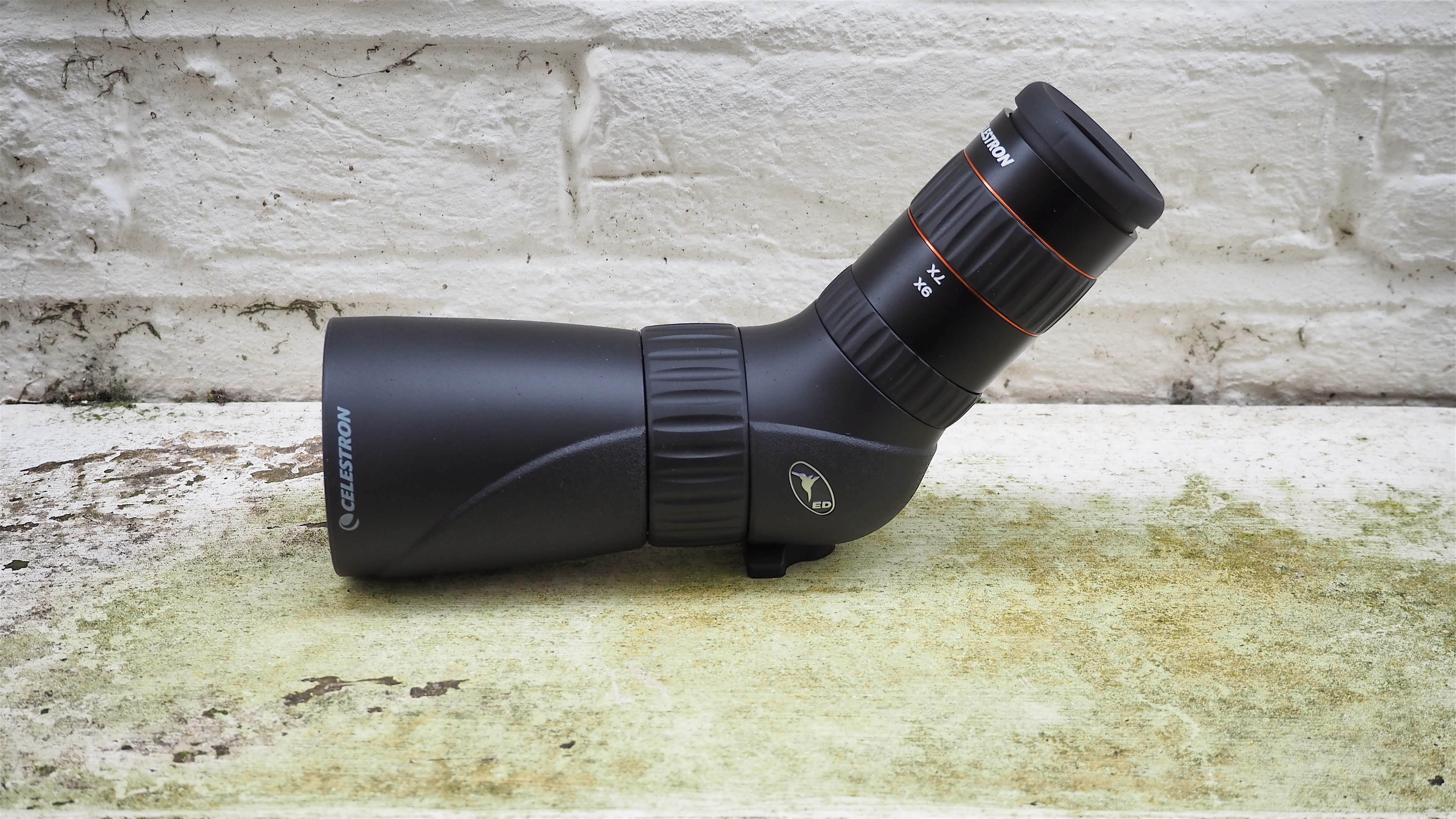
Performance
With 9x and 27x settings printed on the eyepiece, a small nodule at the base of the zoom ring acts as an indicator of where we are in terms of magnification at any time. In keeping things straightforward and simple there are no further markings showing positions between the two extremities. As expected the eyepiece is of the twist-up variety, allowing for comfortable viewing, whether we’re wearing spectacles or not.
If we’re nitpicking we did notice a slight softening and halo effect toward the edges of the frame at times, but not to an extent that it spoiled our view or detracted from the subject.
Sticking with the positives, any instances of chromatic aberration seem to be well under control here. Even when we were trying to spot tell-tale instances of purple fringing between areas of high contrast, such as the dark branches of a tree silhouetted against a featureless sky, we failed to find them.
Generally, the level of sharpness is more than acceptable for the size and versatility of the scope and would suit keen amateurs who can’t quite justify much more expensive optics from the likes of Leica or Zeiss.
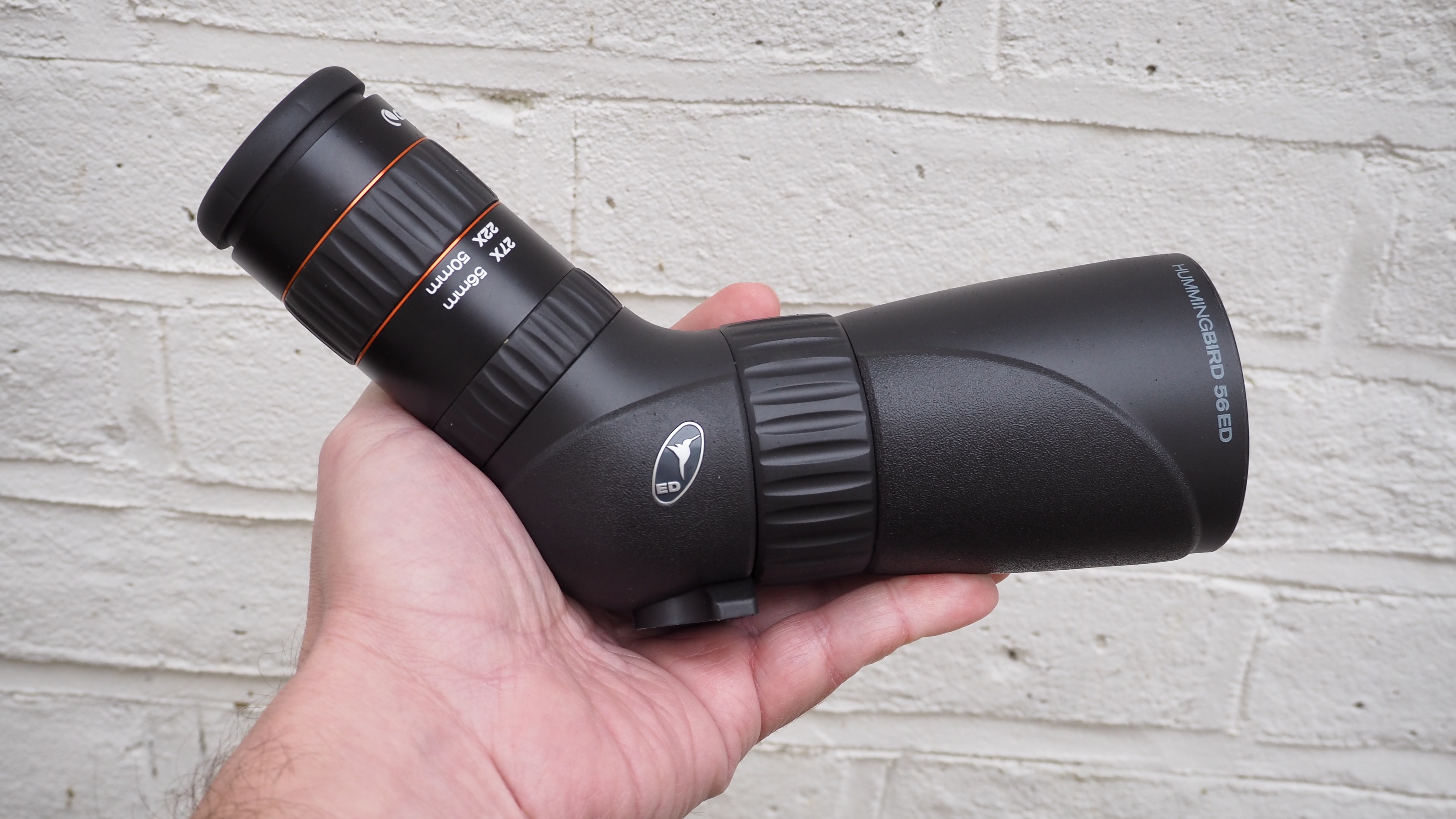
The blurb for this product describes it as rubber armored, and while it looks sturdy enough to withstand the odd accidental knock, the surface is actually quite smooth, as opposed to roughened or dimpled for a firmer grip. We found our fingers therefore naturally coming to rest around the magnification dial and the focus dial, both of which are chunky, knurled, and yes, rubbery. This holding position also allows for swift adjustments to magnification and focus when tracking a subject, so makes practical sense.
Verdict
If you’re considering purchasing the travel-friendly Celestron Hummingbird 9-27x56mm ED Micro Spotting Scope we recommend factoring in the additional purchase of a travel-sized tripod in order to best take advantage of the magnification range on offer and avoid a view marred by judder towards its maximum setting.
That’s not to suggest this scope cannot be readily used handheld as long as we stick to the minimum 9x range; it can. But to limit ourselves to the more modest end of the zoom would mean we’d literally only be getting part of the picture. In conclusion, this is most suited as an option for amateur bird watchers and nature lovers starting out who don’t want the bulk of a full-size scope.
Read more:
• The best spotting scopes
• Best binoculars
• Best budget binoculars under $100
• The best monoculars in 2021
• The best night vision goggles and binoculars
Gavin has over 30 years’ experience of writing about photography and television. He is currently the editor of British Photographic Industry News, and previously served as editor of Which Digital Camera and deputy editor of Total Digital Photography.
He has also written for a wide range of publications including T3, BBC Focus, Empire, NME, Radio Times, MacWorld, Computer Active, What Digital Camera and the Rough Guide books.
With his wealth of knowledge, Gavin is well placed to recognize great camera deals and recommend the best products in Digital Camera World’s buying guides. He also writes on a number of specialist subjects including binoculars and monoculars, spotting scopes, microscopes, trail cameras, action cameras, body cameras, filters and cameras straps.
